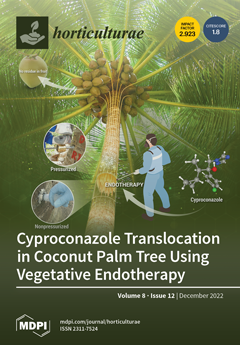Drought stress is an important environmental factor limiting apple yield and fruit quality. Previously, we identified GRETCHEN HAGEN3.6 (GH3.6) as a negative regulator of drought stress in apple trees. Using transgenic
MdGH3 RNAi (knocking down
MdGH3.6 and its five homologs) plants as rootstock can increase drought tolerance, water use efficiency, flowering, and fruit quality of the Fuji scion after drought stress. However, the molecular mechanism behind this phenomenon is still unknown. Here, we performed transcriptome sequencing of the grafted plants (Fuji/GL-3 where Fuji was used as the scion and non-transgenic GL-3 was used as the rootstock, and Fuji/
MdGH3 RNAi where
MdGH3 RNAi was used as the rootstock) under control and drought conditions. Under control conditions, 667 up-regulated genes and 176 down-regulated genes were identified in the scion of Fuji/
MdGH3 RNAi, as compared to the scion of Fuji/GL-3. Moreover, 941 up-regulated genes and 2226 down-regulated genes were identified in the rootstock of
MdGH3 RNAi plants relative to GL-3. GO terms of these differentially expressed genes (DEGs) in scion and rootstock showed associations with plant growth, fruit development, and stress responses. After drought stress, 220 up-regulated and 452 down-regulated genes were identified in
MdGH3 RNAi rootstock, as compared to GL-3. Significantly enriched GO terms included response to abiotic stimulus, cell division, microtubule-based process, metabolic and biosynthetic process of flavonoid, pigment, and lignin. The comparison between the scion of Fuji/
MdGH3 RNAi and Fuji/GL-3 yielded a smaller number of DEGs; however, all of them were significantly enriched in stress-related GO terms. Furthermore, 365 and 300 mRNAs could potentially move from
MdGH3 RNAi rootstock to scion under control and drought conditions, respectively, including FIDDLEHEAD (FDH), RESPONSIVE TO DESICCATION 26 (RD26), ARS-binding factor 2 (ABF2), WRKY75, and ferritin (FER). Overall, our work demonstrates the effects of rootstock on scion at the transcriptional level after drought stress and provides theoretical support for further understanding and utilization of
MdGH3 RNAi plants.
Full article





